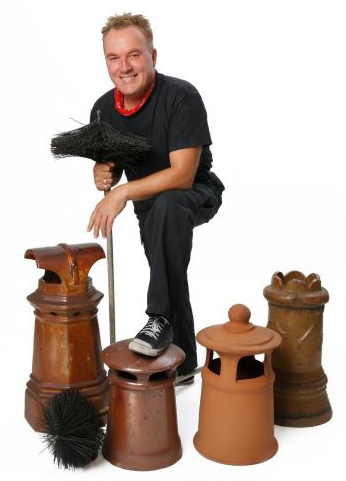History of the English Chimney Sweep.
In the 17th and 18th century it was the governments wishes that all flues and chimneys would be cleaned often to help prevent pollution, problems and household fires from occurring. The chimneys of that period were very large so a master chimney sweep would use small children to climb up inside flues with brushes and metal scrapers to clean them. The young children, often known as ‘climbing boys’, would use there hands and metal scrapers to remove hard tar and soot which would be deposited from the smoke created by burning wood, logs and coal.
It was common for the child to become scared and reluctant to climb so often the young child would be followed by a more experienced older child who would poke the boy’s feet with needles if they slowed down or stopped, or for a small fire to be lit underneath the child, to force them to climb to the top. Everyday the child would be put at great risk from becoming stuck in the chimneys as they narrowed at the top, from breathing difficulties and even falling to their death. The master sweep would be paid a fee which was used to clothe, feed and teach the child his trade.
The children used were parish boys, orphaned children and some were sold to the trade by there by their families. During this time there were no safety clothing or regulations to protect them. In London there was the London Society of Master Sweeps which had its own set of rules, one of which said that boys were not allowed to work on Sundays, they must go to Sunday school and read the bible. The conditions in which these children were kept was dreadful, some were forced to sleep in cellars on bags of soot and washing facilities rarely existed.
In 1803 the ‘Society for Superseding Climbing Boys’ was formed with the intention of finding equipment to clean chimneys without using young children. It was George Smart and then later improved upon by Joseph Glass an engineer from Bristol who has been largely credited with developing the method that is still in use today. There design consisted of a system of canes and brushes which could be pushed up into the chimney from the fireplace below cleaning the flue as it went. Unfortunately at the time these methods were very rarely used as it was still cheaper to use children rather than buy the equipment.
In 1840 an Act of Parliament was approved forbidding anyone under the age of 21 from climbing a chimney, but this had very little effect as penalties were small. It wasn’t until 1864 after many years of campaigning was an Act of Parliament finally approved by the House of Lords outlawing the use of children for climbing chimneys. Lord Shaftsbury’s Act for the Regulation of Chimney Sweepers established a penalty of £10 pounds for offenders. The Act had wide spread support from the police, public and courts which finally signalled the end of ‘climbing boys’.

